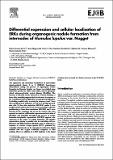Por favor, use este identificador para citar o enlazar a este item:
http://hdl.handle.net/10261/53148COMPARTIR / EXPORTAR:
 SHARE SHARE
 CORE
BASE CORE
BASE
|
|
| Visualizar otros formatos: MARC | Dublin Core | RDF | ORE | MODS | METS | DIDL | DATACITE | |

| Título: | Differential expression and cellular localization of ERKs during organogenic nodule formation from internodes of Humulus lupulus var. Nugget |
Autor: | Sousa Silva, Marta; Fortes, Ana M.; Testillano, Pilar S. CSIC ORCID ; Risueño, María Carmen CSIC ; Suares, María Salomé | Palabras clave: | Humulus lupulus var. Nugget Nodule formation ERK1/2 MAPKs Proliferation |
Fecha de publicación: | 2004 | Editor: | Elsevier | Citación: | European Journal of Cell Biology 83 (8) 425-433 (2004) | Resumen: | The expression and subcellular localization of extracellular signal-regulated kinase 1 or 2 (ERK1/2) homologues (HLERK1/2) during the process of organogenic nodule formation in Humulus lupulus var. Nugget was studied using antibodies specific for ERK1 and ERK2, and for phosphorylated mitogen-activated protein kinases (MAPKs). The increase in HLERK levels, detected by Western blotting 12 hours after wounding suggests their involvement in response to the wounding treatment applied for morphogenesis induction. In dividing cambial cells, occurring in between 4 and 7 days after morphogenesis induction, as well as in dividing prenodular cells (15 days after induction) HLERK1 and/or 2 were localized in the nucleus. However, as soon as nodular cells start proliferating to form shoot meristems, HLERK1 and 2 were detected in the cytoplasm and not in the nucleus. The data reported account for a differential expression and activation of HLERK1 and HLERK2 throughout the process of nodule formation and plantlet regeneration. HLERK1 appears to be expressed in the stages of nodule formation and plantlet regeneration, playing a possible role in controlling cell proliferation and differentiation. HLERK2 may be induced as a response to reactive oxygen species (ROS) generated by wounding of internodes as its expression is reduced in liquid medium with less oxygen availability compared to solid medium. However, addition of a ROS inhibitor to the liquid medium does not result in a further decrease in the HLERK2 level | Descripción: | 9 p.-5 fig. | Versión del editor: | http://dx.doi.org/10.1078/0171-9335-00397 | URI: | http://hdl.handle.net/10261/53148 | DOI: | 10.1078/0171-9335-00397 | ISSN: | 0171-9335 |
| Aparece en las colecciones: | (CIB) Artículos |
Ficheros en este ítem:
| Fichero | Descripción | Tamaño | Formato | |
|---|---|---|---|---|
| European Journal of Cell Biology_Sousa Silva_2004.pdf | 493,85 kB | Adobe PDF |  Visualizar/Abrir |
CORE Recommender
SCOPUSTM
Citations
7
checked on 17-abr-2024
WEB OF SCIENCETM
Citations
8
checked on 26-feb-2024
Page view(s)
343
checked on 24-abr-2024
Download(s)
29
checked on 24-abr-2024
Google ScholarTM
Check
Altmetric
Altmetric
Este item está licenciado bajo una Licencia Creative Commons

